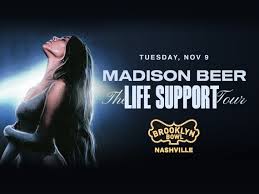“Life Support” Album Review

January 16, 2022
Life Support is the debut album by Madison Beer, released on February 26th, 2021. Beer co-wrote the entire album and helped produce sixteen of the songs. The album was created during Madison’s depressive episode as the singer suffers from borderline personality disorder. The album deals with themes of mental health, heartbreak, and grief. The album is dark pop with aspects of R&B and pop punk. The album has four singles: “Good In Goodbye,” “Selfish, “Baby, and “Boys—t.” Despite the social media hype, none of the singles charted, and Life Support peaked at number 65 on the Billboard Hot 200.
The album starts off with an intro of Madison harmonizing. Even without lyrics, the song is still memorable. The next song is “Good In Goodbye”, which was the lead single, which I believe was a mistake since it’s the weakest song on the album. The lyrics seem lazy compared to the rest of the album. The song is followed by “Default,” a short song about Madison’s struggle with anxiety and depression. If it weren’t for the length, the song would probably be the best song on the album. Default is followed by “Follow the white rabbit”, which is an allusion to Alice in Wonderland and The Matrix. The next song is “Effortlessly.” Possibly the best song on the album, it is about the pharmaceutical industry and how much mental illness can affect your life and the things you used to do “effortlessly.” “Stay Numb and Carry On” takes a twist on the popular phrase “Keep Calm and Carry On” to portray unhealthy coping mechanisms. The next song, “Blue,” has clear Lana Del Rey influences, specifically from her debut album “Born To Die.” In “Blue”, Madison sings about an ill-fated relationship, one of my favorites due to the amazing use of imagery. The next song is an interlude, which is about a relationship crumbling as Madison finds herself outside of her relationship. The song perfectly transitions into the second half of the album.
“Homesick” opens with vocals similar to the album’s opening track, which shows how the albums are separated. “Homesick” sings about finding a place in the universe where you belong. The song concludes with a clip from Madison’s favorite show, “Rick and Morty,” which, while unnecessary, serves as a great transition to the next song, “Selfish,” Madison’s most popular song. “Selfish” is stripped down compared to the other songs, filled with guitar riffs. The song is about Madison realizing the red flags that were always present and going back and forth between blaming herself for not seeing them and knowing it’s not all her fault. The next song, “Sour Times,” is heavily inspired by Tame Impala. The song is about being taken advantage of while vulnerable to heartbreak. “Boys—t” and “Baby” are more lighthearted and fun, a stark contrast from the previous songs. Baby is definitely more Pg-13 than the other songs on the album, but can also count as a double entendre to growing from insecurities. The music video for “Baby” created controversy over “copying” Ariana Grande over things as minuscule as ponytails and falling. “Stained Glass” is about Madison’s struggle with the excessive hate she’s received online since she first got famous at the age of 14. “Emotional Bruises’ ‘ is framed as a love letter but is about Madison not giving her ex another chance at hurting her. The pre chorus of the song is the origin of the album title, using the metaphor of needing life support after so much pain from this relationship. “Everything Happens for a Reason” has a 50s/60s doo-wop vibe, and in the song, Madison rejects the idea that every experience has a purpose while dealing with heartbreak . The final track, “Channel Surfing,” includes clips of the making of the album and ends with her thanking the listeners.
Check it out!
